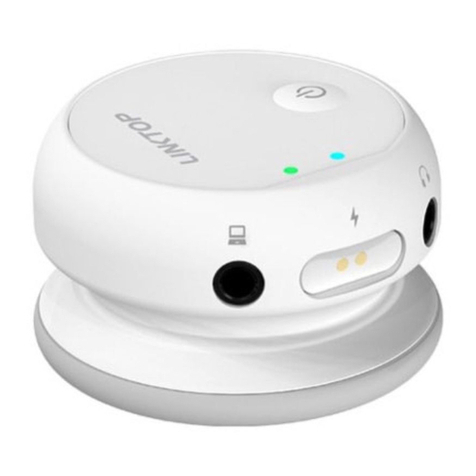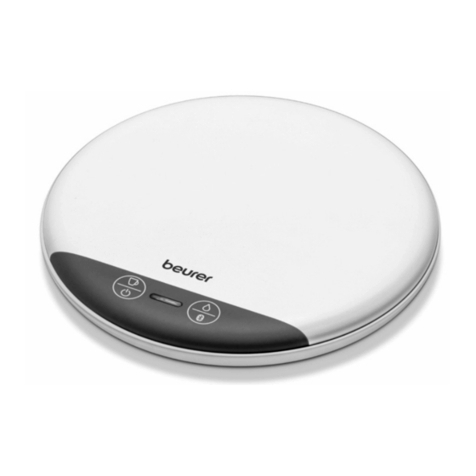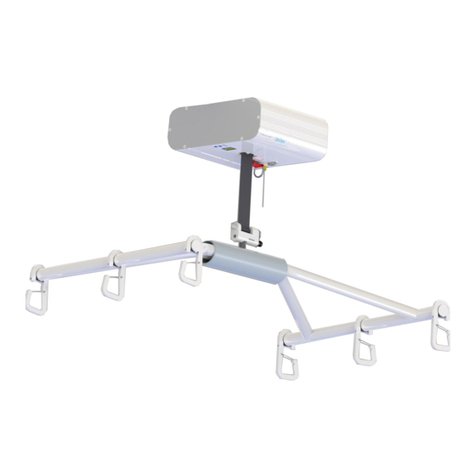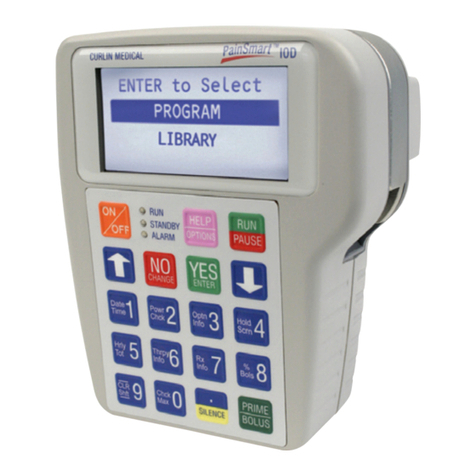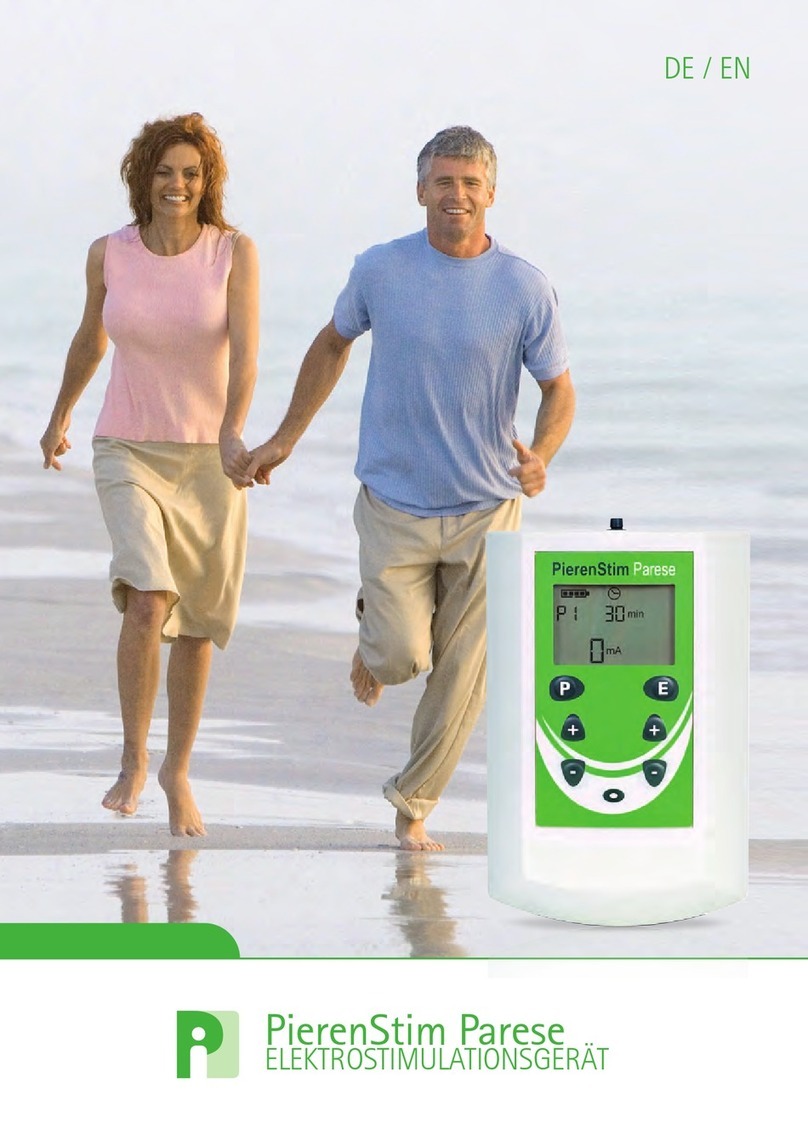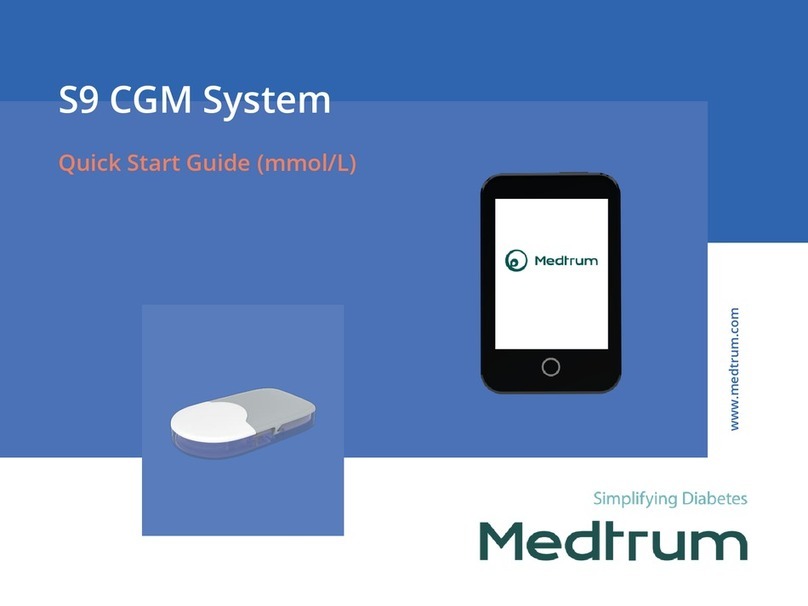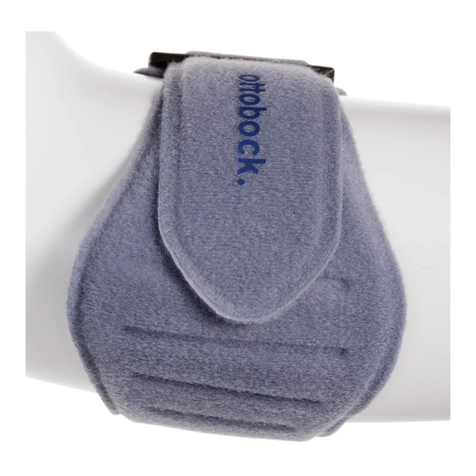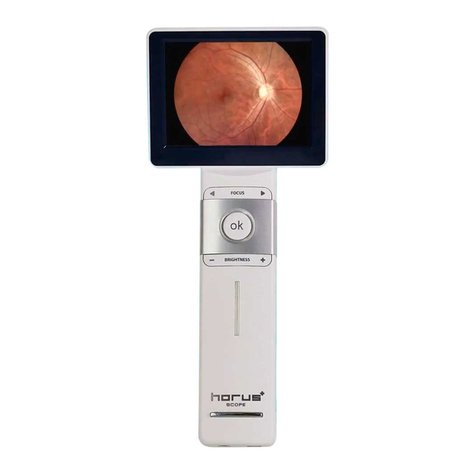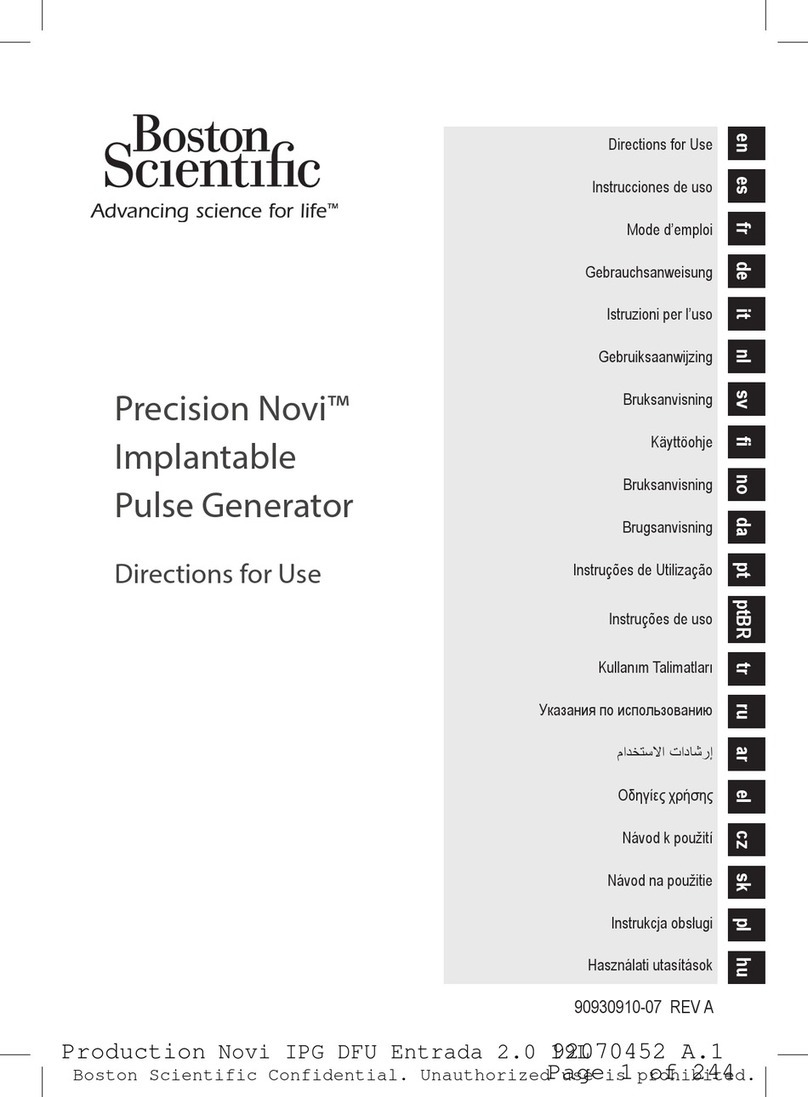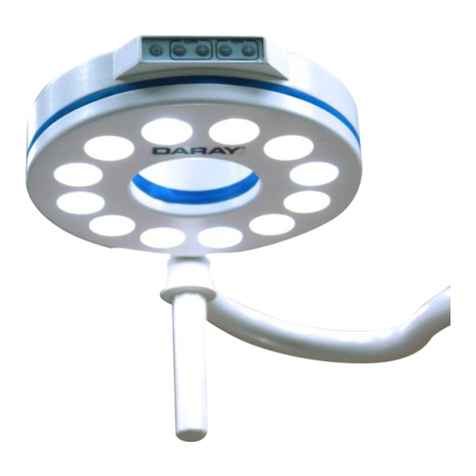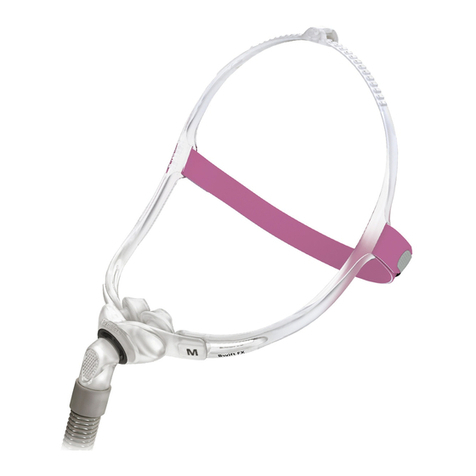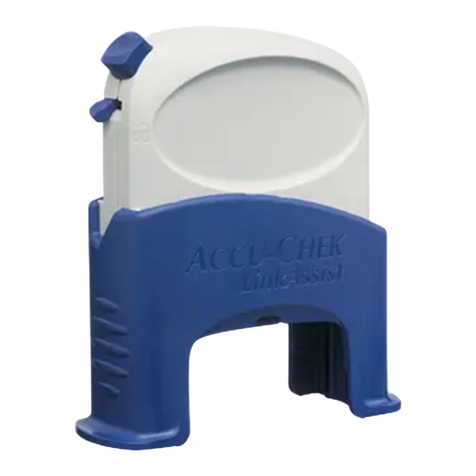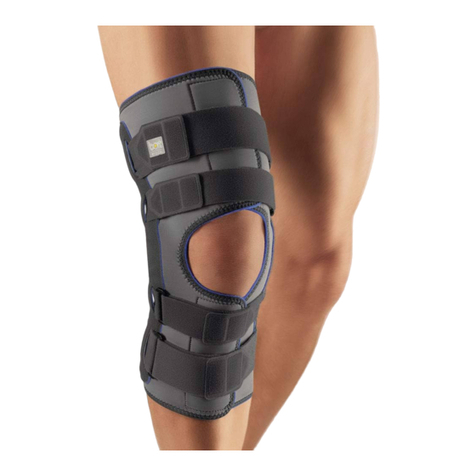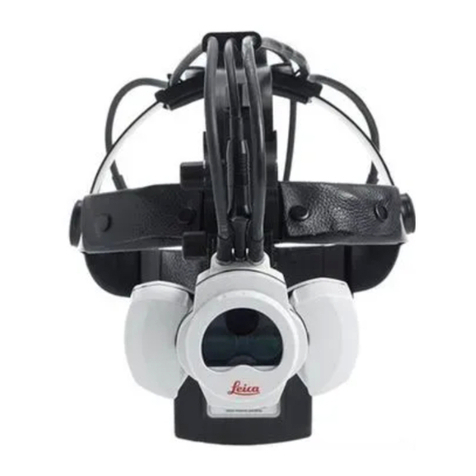Linktop Otoscope NE20 User manual

Otoscope
User Manual
(Version: 1.0)
(Model:NE20)

Introduction
This user manual is a part of a medical product - the
Otoscope. Please read through this brochure before use
and keep them for future reference.
Linktop bears no liability and provides no guarantee with
regard to damage (including indirect damage) arising
due to this user manual not being complied with.Linktop
reserves the right to make technical changes without
notice in the interest of progress. Prior notices will not
be given in case of any amendments within this manual.

Table of contents
1. Safety Information 1
2. Description 3
3. Using Instructions 6
4. Cleaning and Maintenance 8
5. Environment Conditions 8
6. Troubleshooting 9
7. Servicing 9
8. Warranty 9
9. Explanation of utilized symbols 10
10. Electromagnetic Compatibility 11

1. Safety Information
Using this medical product is not a substitute for
visiting a physician and may not delay obtaining
medical assistance in sudden pathological conditions.
This medical product can be operated by adults only.
This medical product is not intended for diagnostics in
emergency conditions! If you suspect any hazard to life
or health (e.g. trouble breathing, impaired
consciousness, significantly increased respiratory rate,
panic), do not use this medical product! In such a
situation, contact a doctor urgently.
Keep the device out of the reach of unsupervised
infants and children.
The cable may constitute a strangulation hazard: any
examination of children should be conducted under
supervision.
Use only original Otoscope parts, spare parts,and
accessories.
The correct and safe function of the device is only
guaranteed if both the device used and its accessories
are provided by Linktop.
Do not perform examinations with the device or put it
to the body while it is being charged.
This medical product is non-sterile. Do not use on
injured tissue.
Do not shine light of the device directly into the eyes.
Prior to commencing examination, please disconnect
the charging cable from the device.
Prior to using the device, make sure that it has no
visible damage.
.
.
.
.
.
.
.
.
.
.
.
.
To assure the correct use of the product, basic safety
measures should always be followed including the
warnings and cautions listed in this manual.
1.1 Warnings

Do not use the device where it may be exposed to
flammable gas.
The device is not allowed to enter or be used in areas
with strong magnetic fields, e.g. MRI scanners.
Do not attempt to replace the battery on your own.
Do not disassemble or attempt to repair and modify the
device or components.Repairs shall only be carried out
by qualified persons.
.
.
.
.
This medical product is an Otoscope. It should be
used solely for checking the details of the earhole,
nasal. This medical product does not analyze the
pictures recorded.
A video shooting made using this medical product may
be transmitted only via applications approved by
Linktop. The videos made using any applications other
than those specified below may not be reliable, which
may lead to their content being interpreted incorrectly
by a doctor and, in consequence, to incorrect
diagnosis. The list of approved applications is
available at the www.linktop.com website.
In case of noticing any irregularities in functioning of
the device or any damage to it, stop using it
immediately and contact the manufacturer.
Do not touch the lens directly by hand or something
hard.
The device should be stored in a clean and dry place.
Protect this device from water, moisture, impact,
dropping, direct sunlight, heat and fire.
The device should be charged only by means of the
charging cable included in the set supplied. In any
other case, use a charger that meets the requirements
described of this manual.
When the product is being charged, all its functions,
including data transmission, are blocked.
The device does not include any parts that can be
replaced by the user on their own.
.
.
.
.
.
.
.
.
.
1.2 Cautions

2. Description
Linktop Otoscope is a portable, handheld optical
magnifying device with short focal length camera, which
is intended for the examination of the ear, the external
auditory canal and the tympanum. The high resolution
camera can provide great image and video quality, there
are 6 LED lights on the tip of the camera which makes
the light path and increase the visual field of view. It has
rechargeable battery powered. It needs to be used with
the USB cables to connect to Android system equipment
and iPhone. By using visualization App, it enables
capturing and transmission of video and still images. It
can be used on any person undergoing a physical
examination. It is suitable for adulthood and children
over 3 years old.
2.1 Intended Use
The main elements of the Otoscope are presented on
Figure 1.
2.2 Components
1
2
34
5
6
Figure 1

The table below includes the description of the LEDs on
the Otoscope:
Description of each component
Cover: Used to control device to automatically turn on
and off by opening and closing the cover.
Camera: For video shooting and photos taking.
6 LED lights: Lighting for camera imaging,
non-removable.
Reset hole: For resetting the device by inserting a thin
rod into the reset hole to short press the reset key.
Indicator light: Two color LED light, used to indicate the
operation, charging and low power status of the device.
Magnetic USB interface: For connecting charging
cable, Android/ iOS device.
Green led is on when the device is on and connected
to an iOS device.
1
2
3
4
5
6
Green led flashes slowly when the battery is below
20% (low power mode), and not be charged.
Blue led is on when it is connected to an Android
device.
Blue light is on when it is charging.
LED is off when it is fully charged.

2.3 Specifications
Product Name
Model
Power supply
Charging voltage
/current
Dimensions
Weight
Battery life
Camera
Protection class
Package Contents
Shelf Life 3 years
IP22
5V DC 2A/1A/500mA
24.5 g
Battery life
● Diameter: 3.9mm
● Pixel: 1,000,000 pixels
● Resolution: 720p
● Focal length: 1.5~2.0cm
● Horizontal viewing angle: (FOV) 70˚
● Frame rate: 15fps
● Otoscope × 1
● User manual × 1
● Magnetic USB-C cable × 1
● Magnetic iOS cable × 1
● Micro USB adapter cable × 1
● Magnetic USB charging cable × 1
● Height: 5.3 inches (134.5mm)
● Diameter: 0.7 inches (17.8 mm)
Otoscope
NE20
Lithium-ion battery (non-removable)

.
.
3. Using Instructions
3.1 Preparations for use
3.1.1 Application
Prior to using the Otoscope, it is necessary to confirm whether
your mobile phone is supported by Otoscope. The available
mobile phones are as follows:
(1) Mobile phone or tablet with Android 6.0 or higher.
(2) iPhone with iOS 9.0 or higher.
Attention:
Always use the most recent version of the application. You can
use the mobile phone to download the application from Google
Play or App Store.
Please make sure that the app permissions of the mobile phone
is open.
.
.
.
Attention:
Use only the enclosed charging cable.
In any other case the charging cable should be connected to a
charger that meets the requirements described in this manual.
When charging is complete, please unplug the charging cable.
3.1.2 Charge the battery
When using the Otoscope for the first time, open the cover to turn
it on. If the battery is low, it will not be able to start up. Use the
supplied charging cable to connect the device (Figure 2) to a
charger to charge it.
Figure 2

3.2 How to Use
(1) Open the cover of the Otoscope to turn it on.
(2) Connect the Otoscope to the mobile phone using the
appropriated cable for your phone type, either the iOS or the
USB-C connector (Figure 3). If your phone has a micro-USB
connector, use the provided Micro USB adapter with the
USB-C cable.
(3) Once you have connected the Otoscope to your mobile phone,
open the application, the application will automatically bind the
device.
(4) Use the application to start to preview captured images.
(5) Point the camera close to the specific spots you want to
observe(Figure 4), and hold the Otoscope at each spot, use
the application to take photos or shoot videos, until you have
finalized the observation.
(6) You can use the application to save and share the photos and
videos.
Figure 3
Figure 4.

4. Cleaning and Maintenance
5. Environment Conditions
5.1 Storage and transport conditions:
.
.
.
Attention:
Do not soak, autoclave or let water or other liquids dip into the
device.
Do not clean it under running water.
The corrosive or polishing detergent is prohibited.
Do not insert the device in alcohol.
Temperature: -20℃to 55℃
Relative humidity: 10% to 95%
Atmospheric pressure: 700 hPa ~1060 hPa
5.2 Operation conditions:
Temperature: 5℃to 35℃
Relative humidity: 10% to 95%
Atmospheric pressure: 700 hPa ~1060 hPa
3.3 Turning the Otoscope off
If you do not use the Otoscope, you can remove the cable and
close the cover to turn the Otoscope off.
Attention:
If the Otoscope is not turned off when it is not in use, it will run out
of battery power.
The Otoscope should be cleaned after each use. It should be
cleaned using a cotton pad or swab moistened with non-alcoholic
disinfectant intended for medical products or personal use.

6. Troubleshooting
7. Servicing
6.1 No image
.
.
.
.
.
.
Check and make sure the cable connected to the phone and
device are properly connected.
Disconnect and reconnect the cable.
Close the app and open it again.
Check and make sure the app permissions of the mobile phone
is open.
Power down and restart the device.
Check the battery level, and recharge the battery.
6.2 Image choppy or delayed
.
.
.
Disconnect and reconnect the cable.
Close the app and open it again.
Power down and restart the device.
In case of noticing any irregularities in functioning of the medical
product, contact the maintenance service at the e-mail address:
Linktop bears no liability and provides no guarantee with regard
to damage (including indirect damage) arising due to this user
manual not being complied with.
8. Warranty
The warranty for the entire product is invalidated if non-genuine
Linktop products or non-original parts are used and if repairs or
modifications are made to the device by persons not authorized
by Linktop. The product has a 2-year warranty. For more
warranty-related information regarding warranty duration, its
scope, its territorial range, and the rights in case of finding a
defect are described in detail at the address: www.linktop.com.

9. Explanation of utilized symbols
The following symbols are used on the device or on the packaging:
1
2
3
4
5
Manufacturer
Batch code
Serial number
Date of manufacture
Use-by date
Unique Device Identifier
CE mark
Importer
Refer to instruction manual/booklet
Caution
IP classification
Type BF Applied Part
Medical device
Part recycled separately from other waste
Do not use if package is damaged
Fragile, handle with care
Humidity limitation
Atmospheric pressure limitation
Temperature limit
Keep away from sunlight
Keep dry
Direct current
Authorized representative in the European
Community /European Union
6
7
8
9
11
12
13
14
15
16
17
18
19
20
21
22
23
10

10. Electromagnetic Compatibility
The Otoscope has been tested and found to comply with the
electromagnetic compatibility (EMC) limits for medical devices.
These limits are designed to provide reasonable protection
against harmful interference in a typical medical installation.
a) Do not use a mobile phone or other devices that emit
electromagnetic fields, near the unit. This may result in
abnormal operation of the unit.
b) Caution: This unit has been thoroughly tested and inspected to
assure proper performance and operation!
c) Caution: this machine should not be used adjacent to or
stacked with other equipment and that if adjacent or stacked
use is necessary, this machine should be observed to verify
normal operation in the configuration in which it will be used.
The Otoscope is intended for use in the electromagnetic
environments specified below. The customer or the user of
the Otoscope should assure that it is used in such an
environment.
Emissions test
RF emissions
CISPR 11
RF emissions
CISPR 11
Group 1
Class B
Harmonic
emissions
IEC 61000-3-2
Voltage function
/flicker emissions
IEC 61000-3-3
Not
applicable
Not
applicable
The Otoscope use RF energy
only for its internal function.
Therefore, its RF emissions
are very low and are not likely
to cause any interference in
nearby electronic equipment.
The Otoscope is suitable for
use in all establishments,
including domestic
establishments and those
directly connected to the
public low-voltage power
supply network that supplies
buildings used for domestic
purposes.
Compliance Electromagnetic environment
- guidance
Manufacturer’s declaration – electromagnetic emissions

The Otoscope is intended for use in the electromagnetic
environment specified below. The customer or the user of the
Otoscope should assure that it is used in such an environment.
Immunity test
Electrostatic
discharge
(ESD)
IEC 61000-4-2
Electrostatic
transient / burst
IEC 61000-4-4
Surge
IEC 61000-4-5
Voltage dips,
short
interruptions
and voltage
variations on
power supply
input lines
IEC 61000-4-11
Power frequency
(50/60 Hz)
magnetic field
30 A/m 30 A/m Power frequency
magnetic fields
should be at levels
±8kV
contact
±2, 4, 8,
15kV air
±2kV for
power supply
lines±1kV for
input/output
lines
±1kV
differential
mode ±2kV
common mode
<5% UT
(>95% dip in
UT)for 0.5
cycle
40% UT
(60% dip in
UT)
for 5 cycles
70% UT
(30% dip in
UT)
for 25 cycles
<5% UT
(>95% d i p
in UT)
for 5 sec
Not
applicable
(Battery
operated
device)
Not applicable
(Battery
operated
device)
Not applicable
(Battery
operated
device)
Mains power quality
should be that of a
typical commercial or
hospital environment.
Mains power quality
should be that of a
typical commercial or
hospital environment.
Mains power quality
should be that of a
typical commercial or
hospital environment.
If the user of the
Otoscope requires
continued operation
during power mains
interruptions, it is
recommended that
the Otoscope be
powered from an
uninterruptible power
supply or a battery.
±8kV
contact
±2, 4, 8,
15kV air
IEC 60601
test level
Compliance
level
Electromagnetic
environment -
guidance
Floors should be
wood, concrete or
ceramic tile. If floors
are covered with
synthetic material,
the relative humidity
should be at least
30%.
Manufacturer’s declaration – electromagnetic immunity

IEC 61000-4-8
NOTE UT is the a.c. mains voltage prior to application of the test level.
The Otoscope is intended for use in the electromagnetic environment
specified below. The customer or the user of the Otoscope should assure
that it is used in such an environment.
Immunity test
Conducted RF
IEC 61000-4-6
Radiated RF
IEC 61000-4-3
IEC 60601
test level
3Vrms
150kHz to
80MHz
10V/m
80MHz to
2.7GHz
Not
applicable
(Battery
operated
device)
10V/m
Compliance
level
Electromagnetic environment -
guidance
Portable and mobile RF
communications equipment
should be used no closer to any
part of the Otoscope, including
cables, than the recommended
separation distance calculated
from the equation application to
the frequency of the transmitter.
Recommended separation
distance
Where p is the maximum output
power rating of the transmitter in
watts(W) according to the
transmitter manufacturer and d
is the recommended separation
distance in meter (m)
Field strengths form fixed RF
transmitters, as determined by
an electromagnetic site survey,
a should be less than the
compliance level in each
frequency range. b
Interference may occur in the
vicinity of equipment marked
with the following symbol:
Manufacturer’s declaration – electromagnetic
characteristic of a
typical location in a
typical commercial or
hospital environment.

NOTE 1 At 80 MHz and 800 MHz, the higher frequency range applies.
NOTE 2 These guidelines may not apply in all situations. Electromagnetic
is affected by absorption and reflection from structures, objects and people.
Test
Frequency
(MHz)
385
450
710
745
780
810
870
930
380-
390
430-
470
704-
787
800-
960
1700-
1990
TETRA
400
GMRS
460,
FRS
460
LTE 13,
17
Band
GSM
800/900
GSM
800/900,
TETRA
800 ,
iDEN 820,
CDMA
850,
LTE 5
Band
GSM
1800 ,
CDMA
1900,
GSM
1900,
DECT,
LTE 1, 3,
4 , 25
Band,
UMTS
Pulse
modulation
18 Hz
FM ±5 KHz
deviation
1KHz sine
Pulse
modulation
217 Hz
Pulse
modulation
217 Hz
Pulse
modulation
18 Hz
1.8 0.3 27
2 0.3 28
2 0.3 28
2 0.3 28
0.2 0.3 9
Band
(MHz)
Service Modulation Maximum
Power (W)
Distance
(m)
Immunity
Test Level
(V/m)
a Field strengths from transmitters, such as base stations for radio
(cellular/cordless) telephones and land mobile radios, amateur radio, AM
and FM radio broadcast and TV broadcast cannot be predicted theoretically
with accuracy. To assess the electromagnetic environment due to fixed RF
transmitters, an electromagnetic site survey should be considered. If the
measured filed strength in the location in which the Otoscope is used
exceeds the applicable RF compliance level above. The Otoscope should
be observed to verify normal operation. If abnormal performance is
observed, additional measures may be necessary, such as reorienting or
relocating the Otoscope.
b Over the frequency range 150kHz to 80 MHz, filed strengths should be
less than 3V/m.
Recommended separation distances between portable and
mobile
1720
1845
1970

2450
5240
5500
5785
2400-
2570
5100-
5800
Xiamen Linktop Technology Co., Ltd.
Address: Room 501-2,502,503, North Building,
Torch Hi-Tech Zone, No.56-58 Huoju Road,
Xiamen, 361000, Fujian, P.R. China.
Website: www.linktop.com
2 0.3 28
2 0.3 9
Bluetooth,
WLAN
802.1 1
b/g/n,
RFID
2450,
LTE 7
Band
WLAN
802.11
a/n
Pulse
modulation
217 Hz
Pulse
modulation
217 Hz

Table of contents
Other Linktop Medical Equipment manuals
